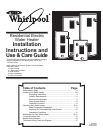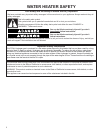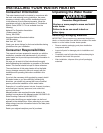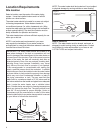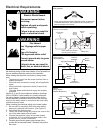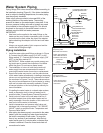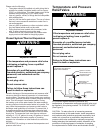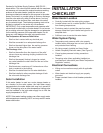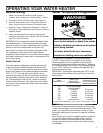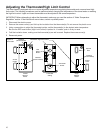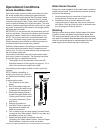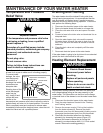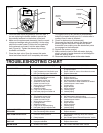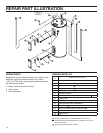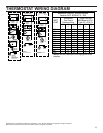
11
Operational Conditions
Anode Rod/Water Odor
Each water heater contains at least one anode rod, which
will slowly deplete while protecting the glass-lined tank
from corrosion and prolonging the life of the water heater.
Once the anode is depleted, the tank will start to corrode,
eventually developing a leak. Certain water conditions will
cause a reaction between this rod and the water. The most
common complaint associated with the anode rod is a “rotten
egg smell” produced from the presence of hydrogen sulfide
gas dissolved in the water.
IMPORTANT: Do not remove this rod permanently as it will
void any warranties. The parts list includes a special anode
that can be ordered if water odor or discoloration occurs.
NOTE: This rod may reduce but not eliminate water odor
problems. The water supply system may require special
filtration equipment from a water conditioning company to
successfully eliminate all water odor problems.
Artificially softened water is exceedingly corrosive because
the process substitutes sodium ions for magnesium and
calcium ions. The use of a water softener may decrease the
life of the water heater tank.
The anode rod should be removed from the water heater
tank every 3 years for inspection. The following are typical
(but not all) signs of a depleted anode rod:
• The majority of the rods diameter is less than 3/8”.
• Significant sections of the support wire (approx. 1/3 or
more of the anode rod’s length) are visible.
If the anode rod show signs of either or both it should be
replaced.
NOTE: Whether reinstalling or
replacing the anode rod, check for
any leaks and immediately correct if
found.
In replacing the anode:
1. Turn off power to the water
heater.
2. Shut off the water supply and
open a nearby hot water faucet
to depressurize the water tank.
3. Drain approximately 5 gallons
of water from tank (Refer to the
“Draining and Flushing” section
for proper procedures). Close
drain valve.
4. Remove old anode rod.
5. Use Teflon
®
tape or approved
pipe sealant on threads and
install new anode rod.
6. Turn on water supply and open nearby hot water faucet
to purge air from water system. Check for any leaks and
immediately correct any if found.
7. Restart the water heater as directed under the
“Operating Your Water Heater” section. See the “Repair
Parts Illustration” section for anode rod location.
®
TEFLON is a registered trademark of E.I. Du Pont De Nemours and Company.
Water Heater Sounds
During the normal operation of the water heater, sounds or
noises may be heard. These noises are common and may
result from the following:
1. Normal expansion and contraction of metal parts
during periods of heat-up and cool-down.
2. Sediment buildup in the tank bottom will create
varying amounts of noise and may cause premature
tank failure. Drain and flush the tank as directed under
the “Draining and Flushing” section.
Stacking
Stacking occurs when a series of short draws of hot water
(3 gallons or less) are taken from the water heater tank.
This causes increased cycling of the heater elements and
can result in increased water temperatures at the hot water
outlet. An anti-scald device is recommended in the hot
water supply line to reduce the risk of scald injury.
Figure 11:
Anode Rod Depletion



